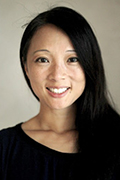Q&A with Associate Professor Genevieve Steiner-Lim and Associate Professor Carolyn Ee
We interviewed two female research leaders at NICM HRI, Associate Professor Genevieve Steiner-Lim and Associate Professor Carolyn Ee about what it's like being a woman in STEM (Science, Technology, Engineering, and Math) and how they are inspiring inclusion when mentoring students.
Associate Professor Genevieve Steiner-Lim

Associate Professor Genevieve Steiner-Lim is an NHMRC Emerging Leadership Fellow and the Clinical Research Platform Lead at NICM HRI. Her cognitive neuroscience research program spans the early detection, prevention, and treatment of cognitive decline in older people with the aim of reducing dementia risk and improving quality of life.
Can you describe what it’s been like for you as a woman in STEM/medical research? What were the biggest challenges you had to overcome as a female researcher?
As a colleague once said to me, “it’s the highest of highs and the lowest of lows.” Working in neuroscience, the field is dominated by people who identify as men, so carving out a space as a group leader who identifies as a woman has had its challenges in terms of being a minority. There is bias and stigma towards women in the field, whether it is direct or indirect. I have had colleagues tell me that other (male) colleagues are intimidated by me as a “young and successful woman” – characteristics that are celebrated and praised in men but stigmatised in women.
Yet, in the words of Einstein, “in the midst of every crisis, lies great opportunity.” Having the opportunity to make a difference for women daily is a real privilege. When we can climb high enough to smash through the glass ceiling, then the most important thing we can do is throw down the ladder for the next generation of scientists who identify as women to follow in our footsteps.
What is your favourite thing about being a researcher in your field?
My favourite thing about my work is that I have the honour of coming to work every day and tapping into my inner personal values – altruism together with fulfilling my passion and love for life-long learning and discovery. This makes it very easy for me to stay intrinsically motivated because I genuinely love what I do, and I’m committed to helping people and learning new things. I am very lucky to work in an environment where I am surrounded by amazing colleagues, students, and importantly the people that we are trying to help with our scientific discoveries – many of whom are women.
Have you witnessed a growth/fall of women in research/STEM?
I have seen more of a push towards inclusive practices and policies in research/STEM over the past decade, but there is still more work to be done. The NHMRC for example, have only recently adjusted their funding award policies to promote equal allocation of grants for people who identify as men, women, non-binary, and other. Prior to this, there were disproportionately high numbers of grants awarded to men compared to women, which makes it extremely difficult for high-performing women to maintain an upward trajectory so that they can continue working in science in Australia. Importantly, many of the people in my networks who identify as men are very supportive and actively promote and foster gender inclusivity. Fortunately, the push for inclusive practices and policies in STEM has not been isolated to gender equality, but inclusivity more broadly in terms of ethnicity, language, LGBTQI+ and so on.
What is innovative about your research?
We take cutting-edge cross-disciplinary research techniques and combine them to examine problems of the upmost importance for populations with unmet needs. Much of the work we do focuses on prevention and early intervention for dementia and those with high risk. We know that 2 out of every 3 dementia cases are in females, but not enough work is being done to understand why this is the case and what can be done to prevent and treat cognitive decline in females with high risk. I’m very proud to say that we have a growing number of projects that are focusing on cognitive health in females where we apply our innovative research methods to solve these wicked problems.
Outside of your family, who is the most influential woman in your life?
This is a very tricky question as there are so many inspiring and influential women I could name. As a scientist, I am a nerd and a geek at heart, and one source of inspiration for me has been from the fictional character, Captain Kathryn Janeway of USS Voyager from the Star Trek series Voyager. Voyager aired from 1995–2001, beginning when I was 12 years old and extending through my high school life, a critical period for laying down the foundations for our future values and belief systems. Captain Janeway was compassionate and understanding, core aspects of femineity, that enhanced and balanced her role as a leader, rather than detracting from it. She continually set high standards and led by example, and always expected the best from her crew. I have a picture of Janeway on my office wall to remind me of the importance of balance, equity, compassion, and excellence in leading and inspiring those around me.
How many women do you currently collaborate with the in the STEM field?
I have the privilege of working with a wide network of multidisciplinary collaborators who identify as women. If I were to guess, I would say some 70% of my collaborators are women. I’m also very lucky to have a wonderful team of staff and students, many of whom identify as women.
Associate Professor Carolyn Ee

Associate Professor Carolyn Ee is an academic GP and the Jacka Foundation Principal Research Fellow at NICM. She is Lead of the Translational Research platform at NICM and Program Lead, Next Practice Western Sydney Integrative Health. Associate Professor Ee is a nationally and internationally recognized emerging leader in primary care chronic disease management, focusing on the intersection between cardiometabolic health, women’s reproductive health and cancer care.
Can you describe what it’s been like for you as a woman in STEM/medical research?
My early experiences were very positive as my supervisors and mentors were also women. Most of the senior and junior academics and PhD candidates in the Department where I started out as an academic (Department of General Practice, University of Melbourne) were female. I felt empowered and confident in stepping up to early leadership roles such as being the co-Chair of the Students in Primary Care Research group as a PhD candidate, and as Board member with the Australian Journal of General Practice (then known as Australian Family Physician). I’ve always had male champions along the way including supervisors and mentors who took the time to help me build and progress through my research career and they have been incredibly influential in my career progression.
What were the biggest challenges you had to overcome as a female researcher?
Unfortunately, balancing work and family commitments remains a major challenge for female researchers. As I raised my family alongside completing my PhD and starting out in my postdoctoral career, I found the squeeze very real. When compounded with the low income that comes with being a postdoctoral researcher, this created a lot of stress in my early postdoctoral years. There is a lot of pressure on early career researchers to publish widely, build collaborations and obtain grant funding. It can be very hard to balance the time and energy pressures with raising a family. The pressure can be the other way around, with archaic societal values persisting. For example, it was not uncommon for the Mothers’ Day celebrations at school or preschool to be scheduled for a midday or midafternoon time, which makes it difficult for working mothers to attend. In contrast, Fathers’ Day events were always scheduled as an early morning breakfast or a Sunday morning! Being a working parent with the additional expectations of being a mother creates a constant need to make decisions about how to prioritise time and energy. This itself can be exhausting and you need to create strong boundaries and systems.
What is your favourite thing about being a researcher in your field?
I love working with fantastic people! I really thrive when I have positive, fun and collaborative teams to be part of. It makes the hard work, deadlines, and long hours worthwhile.
Have you witnessed a growth/fall of women in research/STEM?
I’m not seeing a fall of women in research, but time will tell if we will be able to maintain a sustainable career and become senior research leaders. I’m certainly seeing a lot of interest from women in doing PhDs and embarking on a research career and I’m passionate about helping women grow in research, so that we all can contribute at a high level. We need diversity in perspectives and leadership styles for a robust research culture.
What is innovative about your research?
My research focuses on how health outcomes can be optimized through innovative models of care in primary care settings. Primary care research done by primary care/general practitioner researchers is not necessarily innovative, but it is relatively rare. The generalist lens is different to the single disease focus or even single symptom focus that is more common in health and medical research. Generalists can see systems and connections and consider the individual patient as a whole person and not broken down into separate and discrete parts. This is a perspective vital in making breakthroughs in optimizing outcomes in chronic disease. The key is to understand what models of care provide the best outcomes.
Outside of your family, who is the most influential woman in your life?
Professor Helena Teede is an incredible woman in health and medical research who has grown an impressive team of women in medical research, and in fact dedicates a large proportion of her time cultivating leadership in women in medical research. She has been a big influence on my career since I was a PhD candidate.
How many women do you currently collaborate with the in the STEM field?
Lots and lots! I absolutely love the teams that I am fortunate enough to be part of and most of them are led by women. This includes leadership by fantastic patient advocates such as Carolyn Taylor and Makala Castelli. My collaborations give me the inspiration and motivation to stay in a tough field and continue to optimize how I can have a measurable impact on health while also maintaining my own self-care and providing the time and energy to the most important people in my life – my family.
